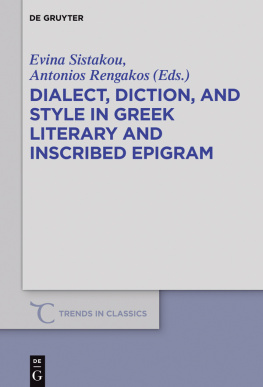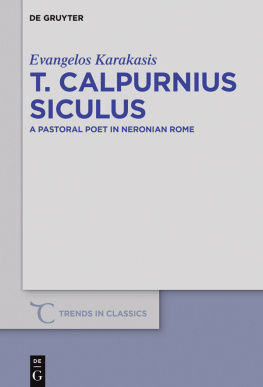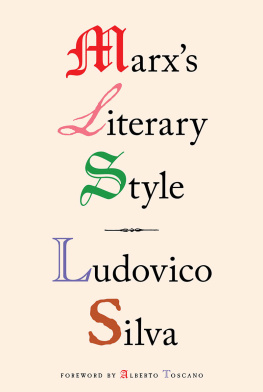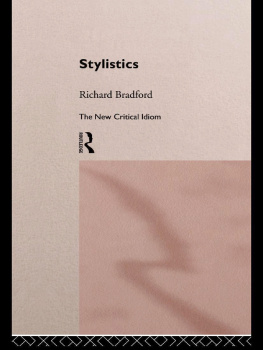Guide

Dialect, Diction, and Style in Greek Literary and Inscribed Epigram
Trends in Classics Supplementary Volumes

Edited by
Franco Montanari and Antonios Rengakos
Scientific Committee
Alberto Bernab Margarethe Billerbeck
Claude Calame Philip R. Hardie Stephen J. Harrison
Stephen Hinds Richard Hunter Christina Kraus
Giuseppe Mastromarco Gregory Nagy
Theodore D. Papanghelis Giusto Picone
Kurt Raaflaub Bernhard Zimmermann
Volume 43

ISBN 978-3-11-049649-9
e-ISBN (PDF) 978-3-11-049879-0
e-ISBN (EPUB) 978-3-11-049702-1
ISSN 1868-4785
Library of Congress Cataloging-in-Publication Data
A CIP catalog record for this book has been applied for at the Library of Congress.
Bibliographic information published by the Deutsche Nationalbibliothek
The Deutsche Nationalbibliothek lists this publication in the Deutsche Nationalbibliografie;
detailed bibliographic data are available on the Internet at http://dnb.dn.de.
2016 Walter de Gruyter GmbH, Berlin/Boston
Logo: Christopher Schneider, Laufen
www.degruyter.com
Preface
Epigram is a broad generic category of ancient Greek poetics, as it encompasses both the literary form written by distinguished poets and the anonymous verses inscribed on stone and various objects, and spans almost a dozen centuries from the archaic and classical period until the rise of the Byzantine empire and beyond. Versatility and varietyin content, tone and dictionare the cornerstones of this genre, whose popularity is evidenced by the numerous epigrammatic corpora that have come down to us. Yet it was the artistic innovation introduced by the Hellenistic learned poets to the epigram that marks the turning point in the history of the genre. The main ideas explored in the present volume were probably conceived for the first time in Ptolemaic Alexandria by the very same poets who saw in the epigram, a poetic form whose brevity dramatically increases the power of the word, the genre par excellence . The aim of the volume at hand is to offer new insights into a key feature of the epigrammatic genre, namely its rhetoric in all its possible manifestations in both literary and inscriptional epigram. The spotlight is turned on Hellenistic and post-Hellenistic epigrams, precisely because it was then that the poets became acutely aware that in epigram every word counts.
Twenty-one contributors bring to the fore the various aspects of this premise, and highlight language, style, and structure of words as a heuristic tool for the interpretation of epigram. The first part is dedicated to dialect and diction. Choice of dialect and dialect mixing are seen as part of the poets strategy in the early Hellenistic era, whereas imitation and variation in terms of diction become a rule in later epigram. Epigram as a formal construction and a genre dependent on sophisticated word design is explored in the second part; discussions feature letter- and word-play, the use of pentameters and syntactical patterns, the rhetoric of riddles and technopaegnia , and the introduction of the epigrammatic diction into epic. The remaining chapters of the volume come under the heading of style. In literary epigram style seems to be defined by theme. Three different thematic areas are viewed from the perspective of their idiosyncratic style, and hence three styles emerge as paradigmatic, namely the sepulchral, the philosophical, and the pastoral. In the last part of the volume a fresh approach to epigrammatic discourse is pursued: the concluding chapters demonstrate that inscriptions feature elaborate linguistic and rhetorical patterns and that style in these anonymous verses is equally essential as in their artistic counterparts.
The papers assembled in this volume were presented during the 9th Trends in Classics conference held in Thessaloniki (2931 May, 2015), which was organized by the Department of Classics of the Aristotle University and the Centre for the Greek Language. This international conference was part of the Action Ancient Greek Dialects of Vital Importance for the Continuity of the Greek Language and the Cultural Tradition, co-financed and managed by the Greek Ministry of Education and Religious Affairs and the European Union (NSRF 20072013). Our thanks go to the Welfare Foundation for Social and Cultural Affairs (K.I.K.P.E.) for sponsoring the conference; we owe a special debt of gratitude to the Vice-President of the foundation, Manos Dimitrakopoulos, who believed in the Trends in Classics project in the first place.
| Evina Sistakou |
| Antonios Rengakos | Thessaloniki, August 2016 |
Dialect and Diction
Ewen Bowie
Doing Doric
This paper has two parts. In the longer, first part I offer some observations on the use of Doric by poets whose work has been transmitted initially via the Garland of Philip and then via the Anthology . In the second and shorter part I consider the case of five poems from a sepulchral monument in Nicaea, poems not read by modern epigraphists but preserved by Book 15 of the Anthology .
The Garland of Philip
Some of Philips poets, especially those of the middle and latter part of the first century BC, have no truck with Doric. This is no surprise in Philodemus, whom neither his Gadarene origin nor his Italian residence, whether in Rome or on the bay of Naples, would have given an incentive to compose any of his 29 surviving epigrams in Doric. Nor is it a surprise in the 15 poems of Parmenion and Diodorus of Sardis respectively, despite the Spartans at Thermopylae being the subject of Parmenion x Gow-Page (= AP 9.304) and a Tarentine setting being that of Diodorus ix Gow-Page (= AP 7.700). But if it is right to think that Honestus was domiciled in Corinth it is somewhat surprising that none of his 22 poems shows any sign of Doric, Less can be argued on the basis of poets of whose epigrams only very few survive, but for what it is worth I note that there is no Doric in the single surviving epigrams of Apollonius, Automedon, Boethus, Diotimus, Etruscus, Quintus, Scaevola or Serapion; in the two epigrams of Sabinus; in the three of Macedonius, Maeandrius, or Polemo; or in the four of Diocles or Secundus.
In certain poets who did choose Doric for some of their surviving poems it might be argued that the dialect is chosen either when there is a thematic or contextual trigger in the poem, or when the poem follows or refashions the work of an earlier poet strongly associated with Doric.
Thus several poems using Doric evoke either a Leonidean or a Theocritean pastoral world and their poets may be choosing to use Doric so as to stress that aspect of a poem. Of Myrinus four transmitted epigrams it is only iii Gow-Page (= AP 7.703), on Thyrsis asleep, that uses Doric:
, ,
,
.
, ,
, .
Thyrsis the rustic, who pastures the nymphs sheep,
Thyrsis whose piping equals Pans reed,
the noon wine-bibber, is under the shady pine, asleep,
and Eros himself has taken a crook and guards his flocks.
oh Nymphs! Nymphs! Wake up the wolf-bold
herdsman, lest the beasts prey should be Eros.











